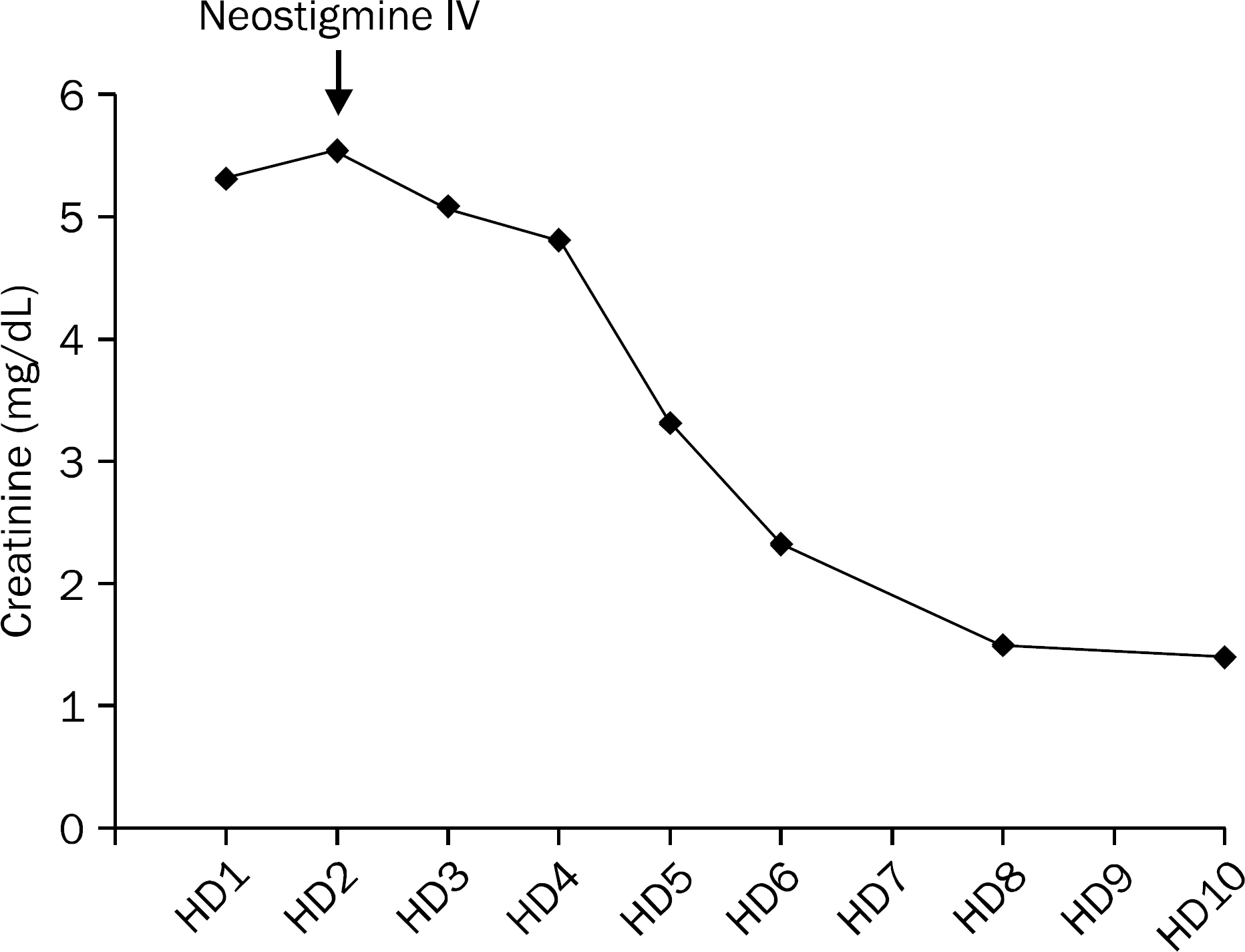Korean J Gastroenterol.
2016 Feb;67(2):103-106. 10.4166/kjg.2016.67.2.103.
Effective and Safe Use of Neostigmine in Treatment of Acute Kidney Injury Associated with Colonic Pseudo-obstruction after Cardiac Surgery
- Affiliations
-
- 1Department of Medicine, Samsung Medical Center, Sungkyunkwan University School of Medicine, Seoul, Korea. yangwonee@gmail.com
- KMID: 2383549
- DOI: http://doi.org/10.4166/kjg.2016.67.2.103
Abstract
- Neostigmine can successfully decompress patients with acute colonic pseudo-obstruction (ACPO) who are unresponsive to conservative therapy. However, neostigmine is contraindicated in renal failure, so it is underused in ACPO patients with renal failure who would be otherwise appropriate candidates. We described the first successfully treated case of acute kidney injury (AKI) with neostigmine in a patient with ACPO. A 72-year-old man who underwent a coronary artery bypass graft surgery 11 days prior presented to the emergency room with abdominal distension, peripheral edema, and dyspnea on exertion. Plain abdominal radiographs and abdomen computed tomography scan showed diffuse colonic dilatation without obstruction. Serum creatinine level was increased five-fold over baseline. We diagnosed the patient as ACPO with AKI. With conservative treatment, renal function failed to improve because the ACPO was not corrected. Administration of neostigmine rapidly resolved ACPO and renal function, avoiding more invasive procedures such as colonoscopic decompression and hemodialysis. Neostigmine appears to be an effective and safe treatment option for ACPO patients with renal failure. Prospective large-scale studies should be carried out to determine the safety and efficacy of neostigmine in ACPO patients with renal failure.
MeSH Terms
Figure
Reference
-
References
1. Saunders MD. Acute colonic pseudo-obstruction. Best Pract Res Clin Gastroenterol. 2007; 21:671–687.
Article2. Tenofsky PL, Beamer L, Smith RS. Ogilvie syndrome as a post-operative complication. Arch Surg. 2000; 135:682–686. discussion 686–687.
Article3. De Giorgio R, Barbara G, Stanghellini V, et al. Review article: the pharmacological treatment of acute colonic pseudoobstruction. Aliment Pharmacol Ther. 2001; 15:1717–1727.4. Ponec RJ, Saunders MD, Kimmey MB. Neostigmine for the treatment of acute colonic pseudo-obstruction. N Engl J Med. 1999; 341:137–141.5. Kayani B, Spalding DR, Jiao LR, Habib NA, Zacharakis E. Does neostigmine improve time to resolution of symptoms in acute colonic pseudo-obstruction? Int J Surg. 2012; 10:453–457.
Article6. Loftus CG, Harewood GC, Baron TH. Assessment of predictors of response to neostigmine for acute colonic pseudo-obstruction. Am J Gastroenterol. 2002; 97:3118–3122.
Article7. Anuras S, Shirazi SS. Colonic pseudoobstruction. Am J Gastroenterol. 1984; 79:525–532.8. Vanek VW, Al-Salti M. Acute pseudo-obstruction of the colon (Ogilvie's syndrome). An analysis of 400 cases. Dis Colon Rectum. 1986; 29:203–210.9. Guler A, Sahin MA, Atilgan K, Kurkluoglu M, Demirkilic U. A rare complication after coronary artery bypass graft surgery: Ogilvie's syndrome. Cardiovasc J Afr. 2011; 22:335–337.10. Abeyta BJ, Albrecht RM, Schermer CR. Retrospective study of neostigmine for the treatment of acute colonic pseudoobstruction. Am Surg. 2001; 67:265–268. discussion 268–269.11. De Giorgio R, Knowles CH. Acute colonic pseudo-obstruction. Br J Surg. 2009; 96:229–239.
Article12. Webb MD. Type I second-degree AV block after neostigmine administration in a child with renal failure. Anesth Prog. 1995; 42:21–22.13. Cronnelly R, Stanski DR, Miller RD, Sheiner LB, Sohn YJ. Renal function and the pharmacokinetics of neostigmine in anes-thetized man. Anesthesiology. 1979; 51:222–226.
Article14. Murphy GS, De Boer HD. Reversal (Antagonism) of neuromuscular blockade. Miller RD, editor. Miller's anesthesia. 8th ed.London, UK: Elsevier Health Sciences;2014. p. 995–1027.15. Saunders MD. Case-based management of acute colonic pseudoobstruction. American Society for Gastrointestinal Endoscopy Leading Edge. 2011; 1:1–6.16. Strodel WE, Dent TL, Nostrant TT, Eckhauser FE, Campbell DA, Marks WH. Treatment alternatives in renal failure and renal transplantation patients with nonobstructive colonic dilatation. Transplantation. 1983; 36:37–40.
Article17. Camilleri M. Acute colonic pseudo-obstruction (Ogilvie's syndrome). [Internet]. UpToDate [updated 2015 Mar 26; cited 2015 Sep 1]. Available from:. http://www.uptodate.com/contents/acute-colonic-pseudo-obstruction-ogilvies-syndrome.18. Aronoff GR. Drug prescribing in renal failure: dosing guidlines for adults and children. 5th ed.Philadelphia: American College of Physicians;2007.
- Full Text Links
- Actions
-
Cited
- CITED
-
- Close
- Share
- Similar articles
-
- Eosinophilic Peritonitis Followed by Acute Colonic Pseudo-obstruction (Ogilvie's syndrome) in an ESRD Patient on CAPD
- Treatment of Acute Colonic Pseudo-obstruction (Ogilvie's Syndrome) with Intravenous Neostigmine
- A Case of Pseudo-obstruction Responding to Neostigmine
- A Case of Colonic Pseudo-Obstruction in a Patient with Parkinson's Disease
- Pyridostigmine for Treatment of Acute Colonic Pseudo-obstruction(Ogilvie's syndrome) in a Older Patient on CAPD



